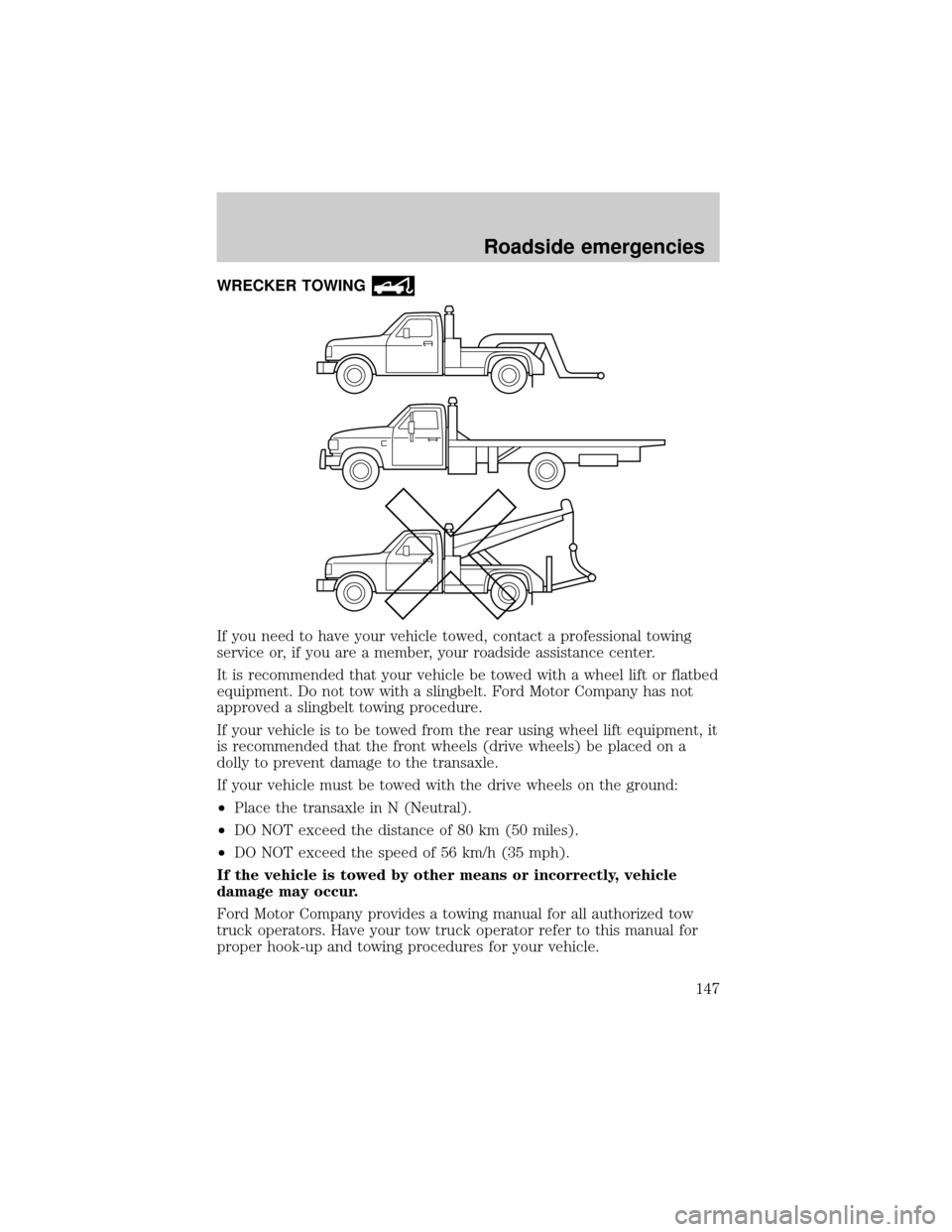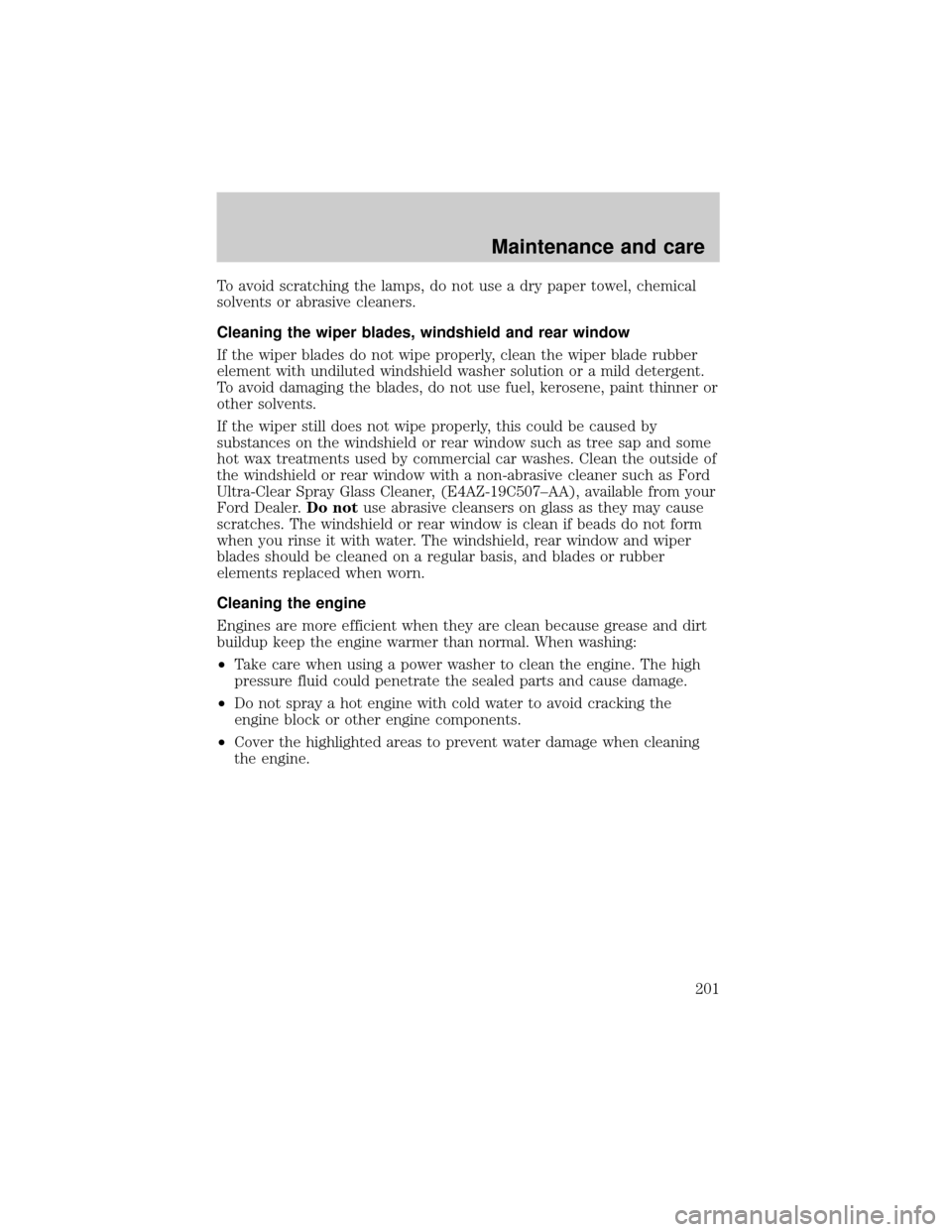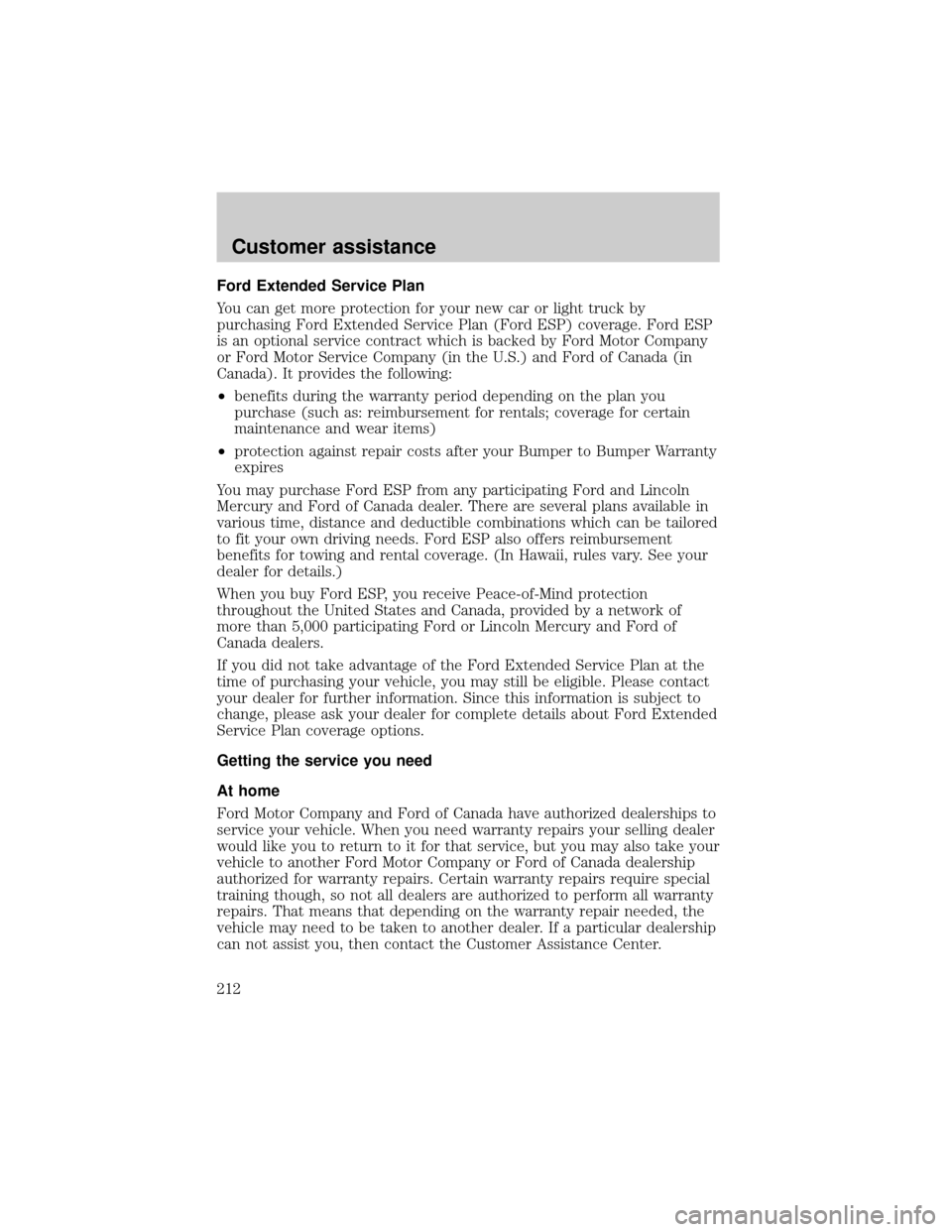2000 FORD TAURUS tow
[x] Cancel search: towPage 147 of 232

WRECKER TOWING
If you need to have your vehicle towed, contact a professional towing
service or, if you are a member, your roadside assistance center.
It is recommended that your vehicle be towed with a wheel lift or flatbed
equipment. Do not tow with a slingbelt. Ford Motor Company has not
approved a slingbelt towing procedure.
If your vehicle is to be towed from the rear using wheel lift equipment, it
is recommended that the front wheels (drive wheels) be placed on a
dolly to prevent damage to the transaxle.
If your vehicle must be towed with the drive wheels on the ground:
²Place the transaxle in N (Neutral).
²DO NOT exceed the distance of 80 km (50 miles).
²DO NOT exceed the speed of 56 km/h (35 mph).
If the vehicle is towed by other means or incorrectly, vehicle
damage may occur.
Ford Motor Company provides a towing manual for all authorized tow
truck operators. Have your tow truck operator refer to this manual for
proper hook-up and towing procedures for your vehicle.
Roadside emergencies
147
Page 174 of 232

Changing the wiper blades
To replace the wiper blades:
1. Pull the wiper arm away from the
windshield and lock into the service
position.
2. Turn the blade at an angle from
the wiper arm. Push the lock pin
manually to release the blade and
pull the wiper blade down toward
the windshield to remove it from the
arm.
3. Attach the new wiper to the
wiper arm and press it into place
until a click is heard.
REAR WINDOW WIPER BLADES
Refer toWindshield Wiper Bladesin this section for more information
on rear wiper blades.
INFORMATION ABOUT UNIFORM TIRE QUALITY GRADING
New vehicles are fitted with tires
that have a rating on them called
Tire Quality Grades. The Quality
grades can be found where
applicable on the tire sidewall
between tread shoulder and
maximum section width. For
example:
²Treadwear 200 Traction AA Temperature A
These Tire Quality Grades are determined by standards that the United
States Department of Transportation has set.
Tire Quality Grades apply to new pneumatic tires for use on passenger
cars. They do not apply to deep tread, winter-type snow tires,
space-saver or temporary use spare tires, tires with nominal rim
diameters of 10 to 12 inches or limited production tires as defined in
Title 49 Code of Federal Regulations Part 575.104(c)(2).
Maintenance and care
174
Page 187 of 232

²Resting your foot on the brake pedal while driving may reduce fuel
economy.
²Combine errands and minimize stop-and-go driving.
Maintenance
²Keep tires properly inflated and use only recommended size.
²Operating a vehicle with the wheels out of alignment will reduce fuel
economy.
²Use recommended engine oil. Refer toLubricant Specifications.
²Perform all regularly scheduled maintenance items. Follow the
recommended maintenance schedule and owner maintenance checks
found in your vehicle Scheduled Maintenance Guide.
Conditions
²Heavily loading a vehicle or towing a trailer may reduce fuel economy
at any speed.
²Carrying unnecessary weight may reduce fuel economy (approximately
0.4 km/L [1 mpg] is lost for every 180 kg [400 lb] of weight carried).
²Adding certain accessories to your vehicle (for example bug
deflectors, rollbars/light bars, running boards, ski/luggage racks) may
reduce fuel economy.
²Using fuel blended with alcohol may lower fuel economy.
²Fuel economy may decrease with lower temperatures during the first
12±16 km (8±10 miles) of driving.
²Driving on flat terrain offers improved fuel economy as compared to
driving on hilly terrain.
²Transmissions give their best fuel economy when operated in the top
cruise gear and with steady pressure on the gas pedal.
²Close windows for high speed driving.
EPA window sticker
Every new vehicle should have the EPA window sticker. Contact your
dealer if the window sticker is not supplied with your vehicle. The EPA
window sticker should be your guide for the fuel economy comparisons
with other vehicles.
It is important to note the box in the lower left corner of the window
sticker. These numbers represent the Range of L/100 km (MPG)
Maintenance and care
187
Page 201 of 232

To avoid scratching the lamps, do not use a dry paper towel, chemical
solvents or abrasive cleaners.
Cleaning the wiper blades, windshield and rear window
If the wiper blades do not wipe properly, clean the wiper blade rubber
element with undiluted windshield washer solution or a mild detergent.
To avoid damaging the blades, do not use fuel, kerosene, paint thinner or
other solvents.
If the wiper still does not wipe properly, this could be caused by
substances on the windshield or rear window such as tree sap and some
hot wax treatments used by commercial car washes. Clean the outside of
the windshield or rear window with a non-abrasive cleaner such as Ford
Ultra-Clear Spray Glass Cleaner, (E4AZ-19C507±AA), available from your
Ford Dealer.Do notuse abrasive cleansers on glass as they may cause
scratches. The windshield or rear window is clean if beads do not form
when you rinse it with water. The windshield, rear window and wiper
blades should be cleaned on a regular basis, and blades or rubber
elements replaced when worn.
Cleaning the engine
Engines are more efficient when they are clean because grease and dirt
buildup keep the engine warmer than normal. When washing:
²Take care when using a power washer to clean the engine. The high
pressure fluid could penetrate the sealed parts and cause damage.
²Do not spray a hot engine with cold water to avoid cracking the
engine block or other engine components.
²Cover the highlighted areas to prevent water damage when cleaning
the engine.
Maintenance and care
201
Page 210 of 232

IDENTIFYING YOUR VEHICLE
Certification label
The National Highway Traffic Safety
Administration Regulations require
that a Certification Label be affixed
to a vehicle and prescribe where the
Certification Label may be located.
The Certification Label is located on
the front door latch pillar on the
driver's side.
1
4
MFD. BY FORD MOTOR CO. IN U.S.A.
EXT PNT: XXXXXX XXXXXX RC: XX DSO: XXXX F0000
BAR INT TR TP/PS R AXLE TR SPR T0000
X XX XXX X XX X XXXX
UTC
ÑFOHT-15294A10-GA
MAXIMUM LOAD=OCCUPANTS + LUGGAGE=XXXKG/XXXXLB
OCCUPANTS: X TOTAL X FR X 2ND X RR OCCUPANTS LUGGAGE
XX XXXKG/XXXXLB
TIRE: XXXX/XXXXX XXX X XXXKG/XXXXLB
PRESSURE (FR) XXX kPa/33 PSI COLD
PRESSURE (RR) XXX kPa/33 PSI COLD
TRAILER TOWING - SEE OWNER GUIDE
DATE: XXXXX GVWR:XXXXX LB/ XXXXX KG
VIN: XXXXXXXXXXXXXXXXX TYPE: XXXXXXXXXXXXXXX FGAWR: XXXXXX/XXXXXXX RGAWR: XXXXXXX/XXXXXXX
THIS VEHICLE CONFORMS TO ALL APPLICABLE FEDERAL
MOTOR VEHICLE SAFETY STANDARDS IN EFFECT ON THE
DATE OF MANUFACTURE SHOWN ABOVE.
Capacities and specifications
210
Page 212 of 232

Ford Extended Service Plan
You can get more protection for your new car or light truck by
purchasing Ford Extended Service Plan (Ford ESP) coverage. Ford ESP
is an optional service contract which is backed by Ford Motor Company
or Ford Motor Service Company (in the U.S.) and Ford of Canada (in
Canada). It provides the following:
²benefits during the warranty period depending on the plan you
purchase (such as: reimbursement for rentals; coverage for certain
maintenance and wear items)
²protection against repair costs after your Bumper to Bumper Warranty
expires
You may purchase Ford ESP from any participating Ford and Lincoln
Mercury and Ford of Canada dealer. There are several plans available in
various time, distance and deductible combinations which can be tailored
to fit your own driving needs. Ford ESP also offers reimbursement
benefits for towing and rental coverage. (In Hawaii, rules vary. See your
dealer for details.)
When you buy Ford ESP, you receive Peace-of-Mind protection
throughout the United States and Canada, provided by a network of
more than 5,000 participating Ford or Lincoln Mercury and Ford of
Canada dealers.
If you did not take advantage of the Ford Extended Service Plan at the
time of purchasing your vehicle, you may still be eligible. Please contact
your dealer for further information. Since this information is subject to
change, please ask your dealer for complete details about Ford Extended
Service Plan coverage options.
Getting the service you need
At home
Ford Motor Company and Ford of Canada have authorized dealerships to
service your vehicle. When you need warranty repairs your selling dealer
would like you to return to it for that service, but you may also take your
vehicle to another Ford Motor Company or Ford of Canada dealership
authorized for warranty repairs. Certain warranty repairs require special
training though, so not all dealers are authorized to perform all warranty
repairs. That means that depending on the warranty repair needed, the
vehicle may need to be taken to another dealer. If a particular dealership
can not assist you, then contact the Customer Assistance Center.
Customer assistance
212
Page 228 of 232

brake ..........................................12
charging system ........................12
check coolant ............................11
cruise indicator .........................11
door ajar ......................................9
high beam ...................................8
low coolant ................................10
low fuel ......................................10
oil pressure ...............................12
safety belt ...................................9
service engine soon ....................9
speed control ............................46
traction control active ................8
turn signal indicator ...................8
Load limits .................................123
GAWR ......................................123
GVWR ......................................123
trailer towing ..........................123
Locks
autolock .....................................69
childproof ..................................54
Lubricant specifications ....207,208
Lumbar support, seats ...............76
Mirrors .........................................51
cleaning ...................................200
heated ........................................55
side view mirrors (power) .......55
Moon roof ....................................51
Motorcraft parts .................184,205
Octane rating ............................182
Odometer .....................................15
Oil (see Engine oil) ..................152
Overdrive ...................................119
Panic alarm feature, remote
entry system ................................61
Parking brake ............................115
Parts (see Motorcraft parts) ....205
Pedals (see Power adjustable
foot pedals) .................................43
Power adjustable foot pedals .....43
Power distribution box
(see Fuses) ...............................136Power door locks ........................54
Power steering ..........................117
fluid, checking and adding ....162
fluid, refill capacity ................206
fluid, specifications ..........207,208
Radio ............................................28
Relays .................................133,138
Remote entry system ............60,61
illuminated entry ......................62
locking/unlocking doors ......60,61
opening the trunk .....................61
panic alarm ...............................61
replacement/additional
transmitters ...............................62
replacing the batteries .............63
Roof rack ...................................129
Safety belts
(see Safety restraints) .....13,78,80
81,82,83,84,86
Safety defects, reporting ..........224
Safety restraints ......78,80,81,82,83
84,85,86,88
belt minder ...............................90
cleaning the safety belts ...93,203
extension assembly ..................89
for adults ....................81,82,83,84
for children ......................100,101
lap belt ......................................87
warning light and chime ..9,13,89
Safety seats for children ..........102
Seat belts
(see Safety restraints) ...............78
Seats ............................................74
child safety seats ....................102
cleaning ............................203,204
SecuriLock passive
anti-theft system ....................70,71
Servicing your vehicle ..............148
Spark plugs,
specifications ......................205,208
Specification chart,
lubricants ............................207,208
Index
228
Page 229 of 232

Speed control ..............................44
Speedometer ...............................13
Starting your vehicle .........108,110
jump starting ..........................142
Steering wheel
tilting .........................................49
Tachometer .................................14
Tires ......................138,174,175,176
changing ...........................138,139
checking the pressure ............176
replacing ..................................177
rotating ....................................176
snow tires and chains ............177
tire grades ...............................175
treadwear ................................175
Towing ................................125,176
recreational towing .................128
trailer towing ..........................125
wrecker ....................................147
Traction control ...................43,116
active light ..................................8
Transaxle
automatic operation ...............118
fluid, refill capacities ..............206
lubricant specifications ..........208
Transmission
fluid, checking and adding
(automatic) .............................163lubricant specifications ..........207
Trip odometer .............................15
Trunk ............................58,60,61,72
remote release ..........................57
Turn signal ...............................8,47
Vehicle dimensions ...................208
Vehicle Identification Number
(VIN) ..........................................211
Vehicle loading ..........................123
Ventilating your vehicle ...........112
Warning chimes ...........................13
Warning lights (see Lights) .........8
Washer fluid ..............................156
Water, Driving through .............124
Windows
power .........................................53
rear wiper/washer .....................48
Windshield washer fluid and
wipers
checking and adding fluid .....156
checking and cleaning .....173,174
liftgate reservoir .....................157
operation ...................................47
replacing wiper blades ...........174
Wrecker towing .........................147
Index
229